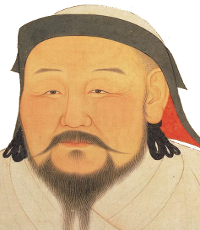Genghis Khan’s family tree
The Mongol empire at its height spanned much of the Eurasian landmass but it was not the creation of only one man. When Genghis Khan died in 1227, the Mongols had not arrived in Europe, not taken the Middle East and not occupied China. These conquests were for Genghis Khan’s successors, his sons and grandsons, to complete. Family trees are always complicated and difficult to remember, but these are the main branches of Genghis Khan’s tree:

Börte, 1161-1230. Temujin’s wife and grand empress of the empire. Börte was not Temujin’s only wife, but the couple seem to have had very fond feelings for each other. She was his trusted advisor with responsibility for her own territory.
Börte gave birth to four sons:

Jochi, 1181-1227. May not have been Temujin’s son since he was born too soon after Börte’s return to her husband. He was never accepted by his brothers as the legitimate successor to their father. When Genghis Khan divided his empire Jochi got the western-most part, a territory which later came to constitute the Golden Horde, in today’s Russia.

Chagatai, 1183-1242, was the leading critic of Jochi and was considered a hotheaded by his brothers. He inherited the Central Asian parts of the empire from his father. Later known as the Chagatai Khanate. He was very fond of airag [Read more: How to make kumis]

Ögedei, 1186-1241, was the third son and successor to Genghis Khan, as a compromise solution instead of picking Jochi or Chagatai. He expanded the empire into the Middle East, attacked the Jin dynasty in China and moved into Korea. It was during his reign that the Mongols expanded into Europe.

Tolui, 1192-1232, was the youngest of Genghis Khan’s sons. He inherited the traditional Mongol heartlands from his father. His descendants ruled Mongolia until 1691.
Tolui, in turn, had four sons, but there were intense rivalries and occasionally wars between them:

Möngke, 1208-1259, improved the administration of the empire. During his reign the Mongols occupied Iraq and Syria. After his death a war broke out between his brothers regarding the right of succession.

Kublai, 1215-1294, was the Mongol ruler who occupied China in 1271 and founded the Yuan dynasty which was to last until 1368 when it was overrun by the Ming. He moved his capital to Beijing.

Hülegü, 1218-1265, occupied much of Western Asia, including Persia, and was responsible for the sacking of Baghdad in 1258. His forces lost an important battle at Ain Jalut, 1260, against the Mamuluk rulers of Egypt. His part of the empire became later known as the Ilkhanate, located in today’s Iran.

Ariq Böke, 1219-1266. was the youngest son of Tolui. After the death of Möngke in 1260, he claimed the throne but was defeated by his brothers. He died only 45 years old. Rumors had it he was poisoned.
External links
- American Center for Mongolian Studies
- Estimate of the number of people killed by the Mongols
- François Pétis, The History of Genghizcan the Great, First Emperor of the Antient Moguls and Tartars, 1710
- Mongolia: A Country Study, 1991
- National Geographic, "Genghis Khan's Secret Weapon Was Rain"
- The Realm of the Mongols
- The Ulaanbaatar Post

